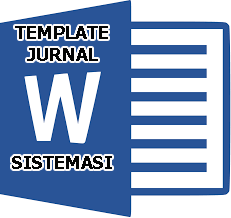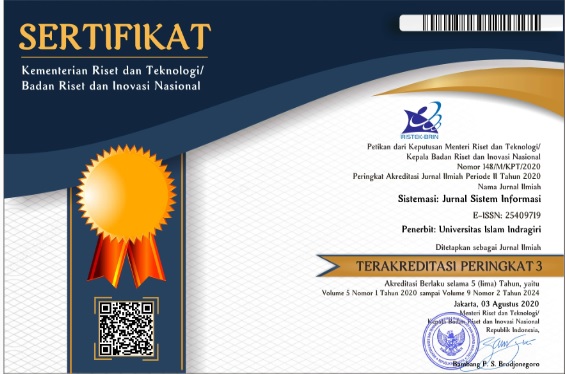Sentiment Analysis of X Application Users on Bitcoin Using the Naïve Bayes Method Optimized with Particle Swarm Optimization (PSO)
Abstract
Keywords
Full Text:
PDFReferences
Z. Martha, “Penggunaan Fitur Media Sosial Instagram Stories sebagai Media Komunikasi,” Jurnal Komunikasi Nusantara, 2021.
R. Armanto, and Muji Gunarto, “Analisis Dampak mEdia Sosial terhadap Penjualan Perumahan: Studi Empiris penggunaan Iklan Facebook dan Instagram,” Jurnal Bisnis, Manajemen dan Ekonomi, 2022.
R. W. Agustin and M. Ayu, “The Impact of using Instagram for Increasing Vocabulary and Listening Skill,” Journal of English Language Teaching and Learning, 2021.
S. Nakamoto, “Bitcoin: sebuah Sistem Uang Tunai Elektronik Peer-to-Peer,” terjemahan dari Bitcoin: A Peer-to-Peer Electronic Cash System.
M. A. Fauzi, N. Paiman, and Z. Othman, “Bitcoin and Cryptocurrency: Challenges, Opportunities and Future Works,” Journal of Asian Finance, Economics and Business, Vol. 7, No. 8, pp. 695–704, Aug. 2020, doi: 10.13106/JAFEB.2020.Vol.7.No.8.695.
F. F. Rachman and S. Pramana, “Analisis Sentimen Pro dan Kontra Masyarakat Indonesia tentang Vaksin COVID-19 pada Media Sosial Twitter,” Indonesian of Health Information Management Journal, 2020.
A. Dwiki, A. Putra, and S. Juanita, “Analisis Sentimen pada Ulasan Pengguna Aplikasi Bibit dan Bareksa dengan Algoritma KNN,” Jurnal Teknik Informatika dan Sistem Informasi, Vol. 8, No. 2, 2021.
A. P. Giovani, A. Ardiansyah, T. Haryanti, L. Kurniawati, and W. Gata, “Analisis senTimen Aplikasi Ruang Guru di Twitter menggunakan Algoritma Klasifikasi,” Jurnal Teknoinfo, Vol. 14, No. 2, p. 115, Jul. 2020, doi: 10.33365/jti.v14i2.679.
Pristiyono, M. Ritonga, M. A. Al Ihsan, A. Anjar, and F. H. Rambe, “Sentiment Analysis of COVID-19 Vaccine in Indonesia using Naïve Bayes algorithm,” IOP Conf Ser Mater Sci Eng, Vol. 1088, No. 1, p. 012045, Feb. 2021, doi: 10.1088/1757-899x/1088/1/012045.
M. R. Handoko, “Sistem Pakar Diagnosa Penyakit selama Kehamilan menggunakan Metode Naive Bayes berbasis Web,” Jurnal Teknologi dan Sistem Informasi (JTSI), Vol. 2, No. 1, pp. 50–58, 2021.
T. M. Shami, A. A. El-Saleh, M. Alswaitti, Q. Al-Tashi, M. A. Summakieh, and S. Mirjalili, “Particle Swarm Optimization: A Comprehensive Survey,” IEEE Access, Vol. 10, pp. 10031–10061, 2022, doi: 10.1109/ACCESS.2022.3142859.
F. D. Ananda and Y. Pristyanto, “Analisis Sentimen Pengguna Twitter terhadap Layanan Internet Provider menggunakan Algoritma Support Vector Machine,” MATRIK : Jurnal Manajemen, Teknik Informatika dan Rekayasa Komputer, Vol. 20, No. 2, pp. 407–416, May 2021, doi: 10.30812/matrik.v20i2.1130.
H. Jahanshahloo, F. Irresberger, and A. Urquhart, “Bitcoin under the Microscope,” British Accounting Review, 2023, doi: 10.1016/j.bar.2023.101237.
Y. Kurnia, E. D. Kusuma, L. W. Kusuma, Suwitno, and W. Apridius, “Perbandingan Naïve Bayes dan CNN yang dioptimasi PSO pada Identifikasi Berita Hoax Politik Indonesia,” bit-Tech, Vol. 6, No. 3, pp. 340–352, Apr. 2024, doi: 10.32877/bt.v6i3.1225.
H. B. Jatmiko, N. T. Kurniadi, and D. Maulana, “Optimasi Naïve Bayes dengan Particle Swarm Optimization untuk Analisis Sentimen Formula E-Jakarta,” Journal Automation Computer Information System, 2022.
A. S. Talita, O. S. Nataza, and Z. Rustam, “Naïve Bayes classifier and Particle Swarm Optimization feature selection method for classifying intrusion detection system dataset,” in Journal of Physics: Conference Series, IOP Publishing Ltd, Feb. 2021. doi: 10.1088/1742-6596/1752/1/012021.
M. Dogucu and M. Çetinkaya-Rundel, “Web Scraping in the Statistics and Data Science Curriculum: Challenges and Opportunities,” Journal of Statistics and Data Science Education, Vol. 29, No. S1, pp. S112–S122, 2021, doi: 10.1080/10691898.2020.1787116.
B. Hakim, “Analisa Sentimen Data Text Preprocessing pada Data Mining dengan menggunakan Machine Learning,” JBASE - Journal of Business and Audit Information Systems, Vol. 4, No. 2, Aug. 2021, doi: 10.30813/jbase.v4i2.3000.
R. A. Supono and M. A. Suprayogi, “Perbandingan Metode TF-ABS dan TF-IDF pada Klasifikasi Teks Helpdesk menggunakan K-Nearest Neighbor,” Jurnal RESTI (Rekayasa Sistem dan Teknologi Informasi), Vol. 5, No. 5, pp. 911–918, Oct. 2021, doi: 10.29207/resti.v5i5.3403.
S. D. Prasetyo, S. S. Hilabi, and F. Nurapriani, “Analisis Sentimen Relokasi Ibukota Nusantara menggunakan Algoritma Naïve Bayes dan KNN,” Jurnal KomtekInfo, pp. 1–7, Jan. 2023, doi: 10.35134/komtekinfo.v10i1.330.
M. Zhao, H. Zhao, and M. Zhao, “Particle Swarm Optimization Algorithm with Adaptive Two-Population Strategy,” IEEE Access, Vol. 11, pp. 62242–62260, 2023, doi: 10.1109/ACCESS.2023.3287859.
DOI: https://doi.org/10.32520/stmsi.v14i4.5390
Article Metrics
Abstract view : 380 timesPDF - 140 times
Refbacks
- There are currently no refbacks.

This work is licensed under a Creative Commons Attribution-ShareAlike 4.0 International License.









